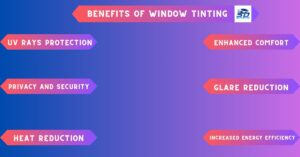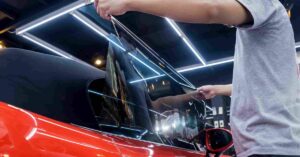Top 5 Window Tint Issues and How to Avoid Them
Window tint or film not only makes your car look cool but also provides various advantages. Such advantages include improving the vehicle’s visual appearance and protection of people as well as the vehicle’s interior against the sun’s harmful UV rays.
True, but only if you do it right.
However, like any other car feature, window film has issues that car owners should know about. Understanding common car window tint issues and knowing how to avoid them is essential to ensure optimal performance and longevity of the film or tint. Car owners can benefit from window film’s advantages without experiencing unneeded obstacles if they are aware and take proactive steps.
Want to avoid mistakes with window tinting? This guide will help you identify them and let you know what to do instead!
What is car window tinting?

Car window tinting is a thin layer of film usually installed on the interior of a car’s windows. Window tint provides different benefits. Such advantages include improving the vehicle’s visual appearance and protection of people as well as the vehicle’s interior against the sun’s harmful UV rays. It carefully adheres to the inside surface of the windows using adhesive, creating a protective barrier.
Common car window films issues
Window tint issues are more common with DIY jobs. Many people try to install window tint themselves to save money, but they frequently encounter more issues in the long term.
Here are some of the most common DIY window tinting issues
- Peeling
- Discoloring
- Bubbling
- Gapping
- Poor Installation
Peeling

Car window tint peel due to various factors. Poor installation, exposure to severe temperatures, subpar coatings, and aging are a few frequent causes of peeling. If the film was not applied correctly or low-quality adhesive was used during installation, it can lead to premature peeling. Additionally, exposure to high temperatures from the sun weakens the adhesive over time and causes peeling. Aging or normal wear and tear can also cause the film to wear down and peel along the sides or in other places.
Discoloring
The discoloration is another common DIY window tinting issue. Window films are constantly exposed to sunlight and UV rays, and the heat damages the interior. Cheaper dyes fade rapidly and may take on a purple color. If your tint begins to have purple tinges, it’s a sign that the dye was defective or of poor quality.
Tints can also become dim or hazy if applied incorrectly. This is most commonly caused by a moist car surface during installation. When water gets stuck behind the tint and evaporates, it makes the rest of the film cloudy.
Bubbling
Bubbling can be caused by improper installation, trapped air or moisture during installation, and low-quality films. When the film is not applied smoothly and evenly onto the glass surface, air or moisture can get trapped and lead to the formation of bubbles. These bubbles can be small and barely noticeable or larger and more visible, affecting the appearance and functionality of the film.
Gapping
If you try to apply window tint or film yourself, it is common to encounter little gaps or uneven spaces after installation. Most of the time, these gaps show up in do-it-yourself projects where the application process could use more precision. Pay close attention to the edges of the windows and areas around door handles, as these are common spots where uneven lines can occur. Rectifying these gaps may require removing the entire tint and starting the installation process anew. However, this can be more time-consuming and costly than seeking professional assistance from the beginning.
Poor Installation
Improper installation is a significant cause of car window tint issues. When the film is not installed correctly, it may not adhere properly to the glass surface, leading to premature peeling, bubbling, or distortion. Also, a bad fitting can leave gaps or edges that aren’t even, which makes the car look bad overall.
How to avoid car window films issues

To ensure a long lasting and trouble free experience with car window tint, consider the following preventive measures to avoid car window tint problems.
- Choose Quality Films
- Professional Installation of car window tints
- Proper Maintenance of tints or films
- follow window tint law in san diego
Choose Quality Films
To avoid common problems with vehicle tints, it’s important to buy high quality window tints. Quality films are made to last longer and stay the same color for longer. They are also made to fight fading and sun damage. Choose SD Auto Style for a high-quality window tint services in San Diego for your specific needs.
Professional Installation of car window tints
Car window films work best and last longer when they are put on correctly. It is recommended to have your window film installed by experienced professionals who follow industry best practices. Experts at SD Auto Style know how to make sure the application is done right, so problems like bubbling, peeling, or bad adhesion are less likely to happen.
Proper Maintenance of tints or films
Car window tints need to be taken care of regularly to keep looking good and working well.
- Avoid using abrasive cleaning agents or rough materials that can scratch the film.
- Instead, use a mild soapy water solution and non-abrasive, soft cloth to clean the windows.
- To avoid inadvertent damage, use ice scrapers and parking permits with caution.
Follow window tint law in san diego
In San Diego, non reflective window tint is allowed on the front side windows. The tint or film must allow at least 70% of light to pass through the window. You can apply any darkness of window tint for the rear side windows, as long as the vehicle has dual side mirrors. The windshield must have a non reflective tint limited to the top 4 inches from the top of the windshield.
Follow window tint law in San Diego to avoid car window tint issues. Remember to stay updated or informed about any changes in the window tint laws to ensure that your vehicle meets the legal requirements in San Diego.
FAQ’s
Here are some Benefits of window tinting.
- Diminishes health risks
- Cuts hazardous glare
- Increased security
- Enhanced privacy
- Increased comfort
- Enhance the elegance
- Increase resale value
- It’s fast and easy
It is best to follow the guidelines provided by the professional installer. They may recommend keeping the windows closed for a specific period to allow the film to properly adhere to the glass.
Yes, that is illegal. The only percentage allowed is 70% if combined with factory-tinted windows.
High-quality window films are designed to have minimal interference with electronic signals. However, low-quality or metallic films may affect signal strength to some extent. It’s advisable to choose non-metallic films or consult with professionals to minimize any potential impact on electronic devices.
Standard window tinting films are reasonably priced and have a lifespan of five years. The price of premium tints made of polyester, metal, or ceramic will be higher, but they will last a lot longer. Avoid buying inexpensive window tint since it will need to be replaced every year to two.
San Diego does not have specific restrictions on the color of window tint. But different tint colors can make it harder to see and can be annoying to other drivers. Choosing a color that does not compromise safety or impede visibility is advisable.
One of the top benifit of automotive window tints or films is that the film blocks heat from entering your vehicle. Even when your automobile is parked in the scorching sun, the insides are kept safe. However, the additional heat might gradually degrade the adhesives in your film, leading to eventual bubbling or peeling.
Yes, law enforcement officers have the authority to measure the darkness of your window tint during traffic stops or inspections. To determine if the window tint on your car complies with the legislation, they could utilize tint meters.
Yes, within five years of installation, the majority of automobile window tints deteriorate from 99% to 70%. However, the “fade rate” may vary depending on the material’s quality. Materials of lower quality will fade more quickly. Better materials will age more slowly.




